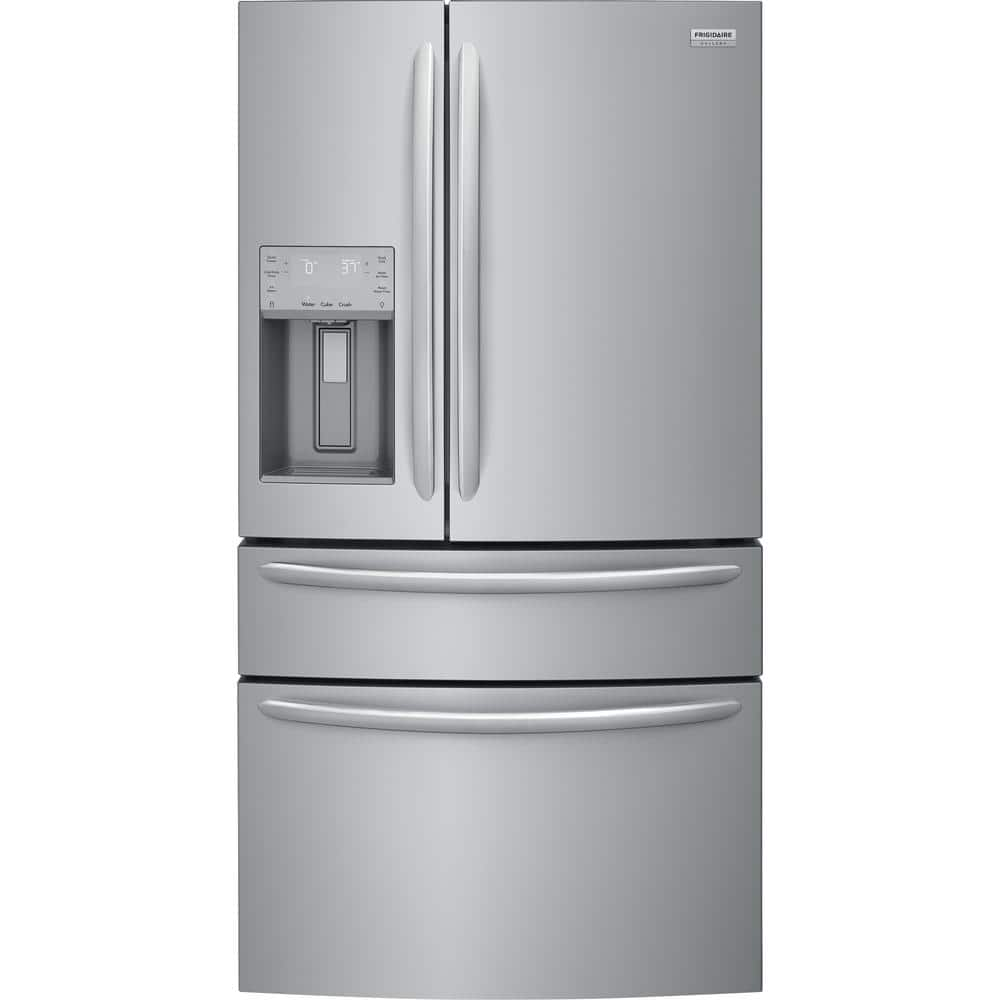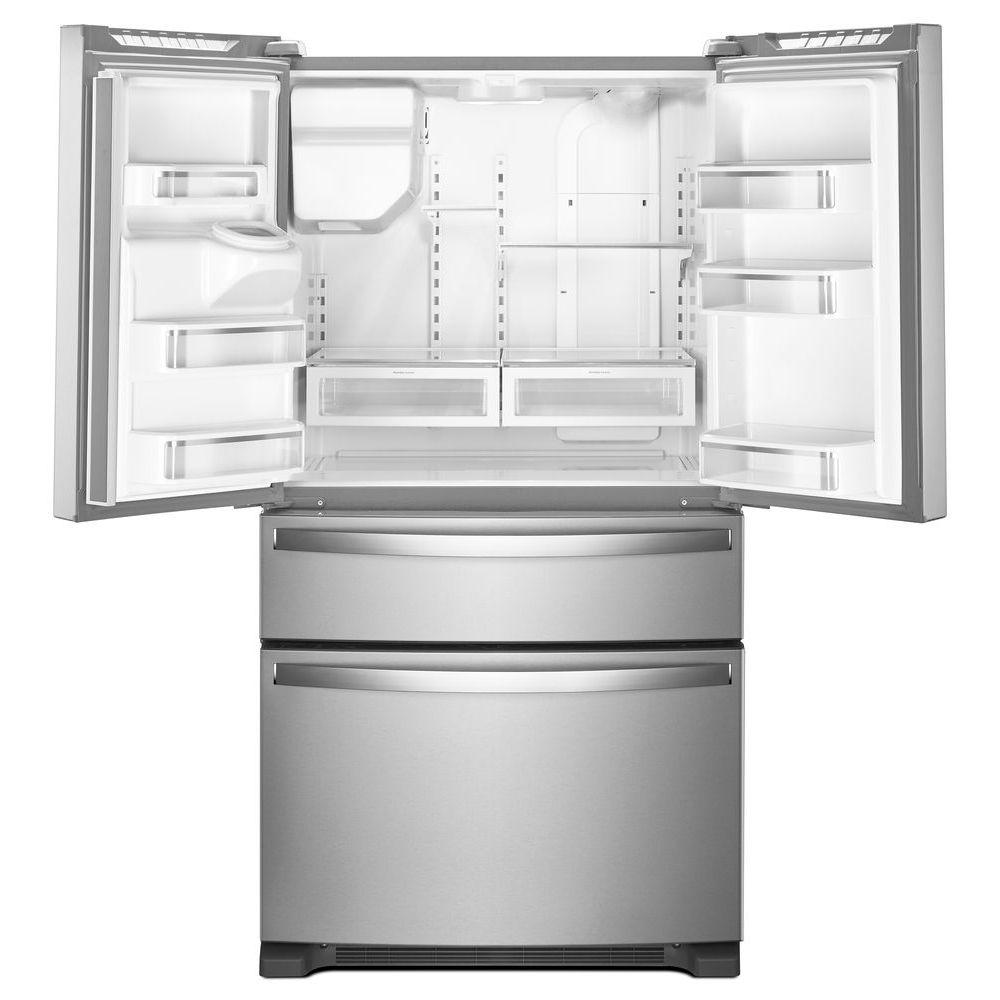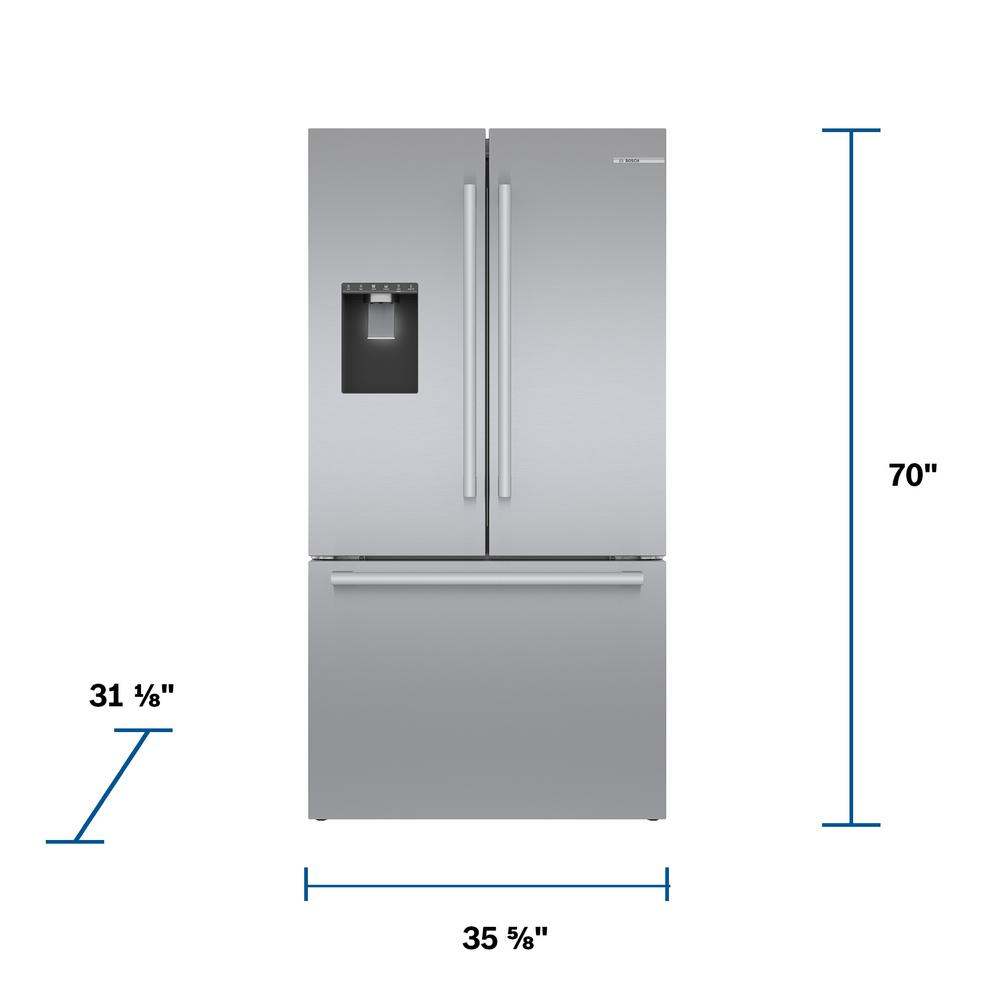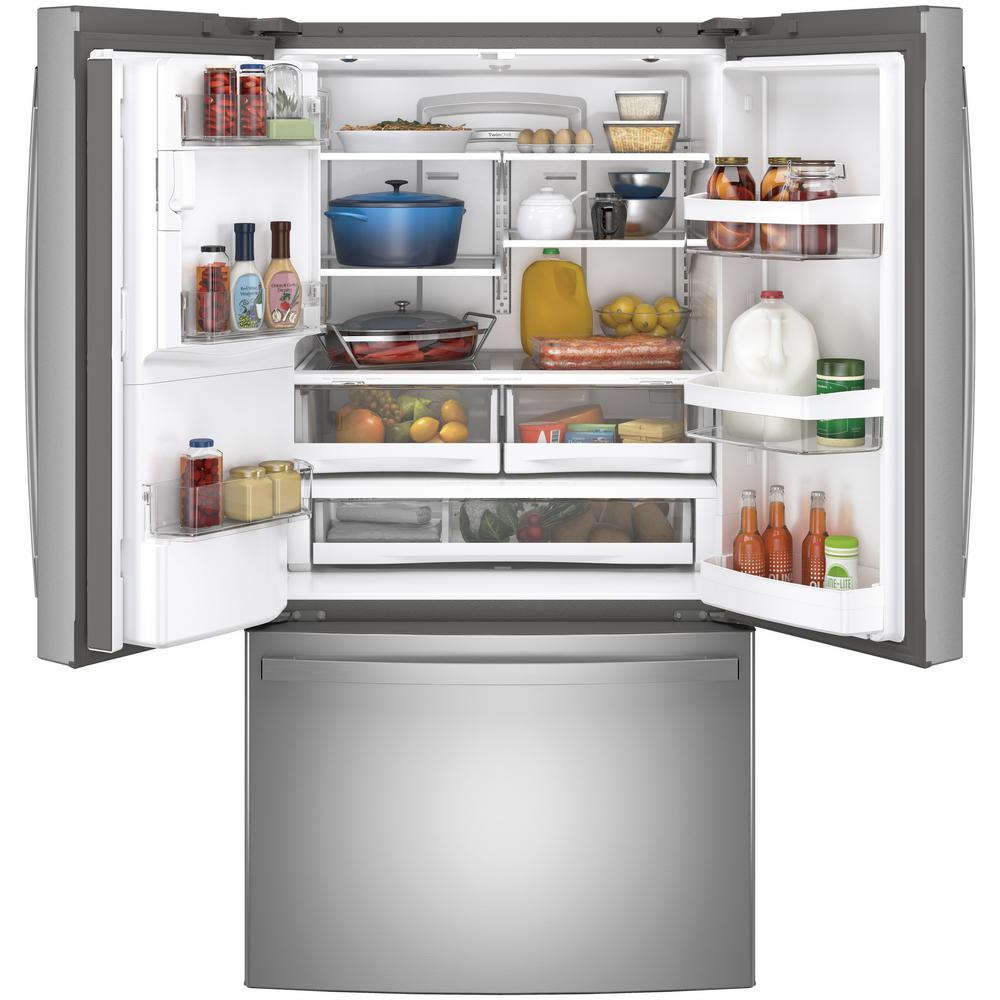Frigidaire 36 in. W 21.7 cu. ft. 4-Door French Door Refrigerator in Smudge-Proof Stainless Steel, Counter Depth
Switch from refrigerator to freezer with Custom-Flex Temp Drawer. Adjustable storage with flip-up shelf and expandable door bin. Crispers keep produce fresher longer with auto moisture removal.
The Frigidaire 4-Door French Door refrigerator offers the Custom-Flex Temp Drawer, which fully switches from fridge to freezer, and offers the widest range in temperature settings (-6 to 45 degrees) on the market. CrispSeal crispers help keep fruits and vegetables fresh longer, and it’s easy to organize and clean with SpaceWise organization system and Smudge-Proof stainless steel.
- Custom-Flex Temp Drawer can be set from -6° to 45°
- SpaceWise organization system including a flip-up shelf to fit taller items and an expandable door bin
- OpenAccess Door allows you to reach up to 75% of your fresh food by opening just one door
- Auto CrispSeal Crisper Drawers keeps your produce fresh
- TwinTech cooling system keeps food fresh by maintaining consistent temperatures in both the refrigerator and freezer
- PureSource Ultra II ice and water filtration remove 99.3% of lead and 99.9% of cysts from your household water
- PureAir Ultra II air filter keeps food in your refrigerator fresh by removing odor particles with fast-acting, highly absorbent carbon technology
- Extra tall ice and water pocket so you can easily fill tall pitchers and sports bottles with a 10 inch exterior ice and water pocket
- Quick freeze option lets you quickly freeze foods so they stay at their freshest–set this option before a large grocery run so your food freezes faster once you get home
- ENERGY STAR Certified for maximum energy savings
- Star-K Certified Sabbath Mode
Additional information
| Depth (Excluding Handles) | 29.625 |
|---|---|
| Depth (Including Handles) | 30.02 |
| Depth (Less Door) | 29.625 |
| Depth With Door Open 90 Degrees (In) | 46.875 |
| Height to Top of Door Hinge (in.) | 70 |
| Height to Top of Refrigerator (in.) | 70.125 |
| Product Depth x Height x Width (in.) | 32.06 x 70 x 36 |
| Refrigerator Width (In.) | 36 |
| Certifications and Listings | CSA Certified,CSA Listed,ETL Listed,Energy Star,Star-K |
| Manufacturer Warranty | 1 year parts and labor |
Twenty-one, XXI or 21 may refer to:
- 21 (number), the natural number following 20 and preceding 22
- The years 21 BC, AD 21, 1921, 2021
36 may refer to:
- 36 (number), the natural number following 35 and preceding 37
- 36 BC, 1st century BCE
- AD 36, 1st century
- 1936, 20th century
- 2036, 21st century
4 (four) is a number, numeral and digit. It is the natural number following 3 and preceding 5. It is a square number, the smallest semiprime and composite number, and is considered unlucky in many East Asian cultures.
7 (seven) is the natural number following 6 and preceding 8. It is the only prime number preceding a cube.
As an early prime number in the series of positive integers, the number seven has greatly symbolic associations in religion, mythology, superstition and philosophy. The seven Classical planets resulted in seven being the number of days in a week. 7 is often considered lucky in Western culture and is often seen as highly symbolic. Unlike Western culture, in Vietnamese culture, the number seven is sometimes considered unlucky.
A door is a hinged or otherwise movable barrier that allows ingress (entry) into and egress (exit) from an enclosure. The created opening in the wall is a doorway or portal. A door's essential and primary purpose is to provide security by controlling access to the doorway (portal). Conventionally, it is a panel that fits into the doorway of a building, room, or vehicle. Doors are generally made of a material suited to the door's task. They are commonly attached by hinges, but can move by other means, such as slides or counterbalancing.
The door may be able to move in various ways (at angles away from the doorway/portal, by sliding on a plane parallel to the frame, by folding in angles on a parallel plane, or by spinning along an axis at the center of the frame) to allow or prevent ingress or egress. In most cases, a door's interior matches its exterior side. But in other cases (e.g., a vehicle door) the two sides are radically different.
Many doors incorporate locking mechanisms to ensure that only some people can open them (such as with a key). Doors may have devices such as knockers or doorbells by which people outside announce their presence. (In some countries, such as Brazil, it is customary to clap from the sidewalk to announce one's presence.) Apart from providing access into and out of a space, doors may have the secondary functions of ensuring privacy by preventing unwanted attention from outsiders, of separating areas with different functions, of allowing light to pass into and out of a space, of controlling ventilation or air drafts so that interiors may be more effectively heated or cooled, of dampening noise, and of blocking the spread of fire.
Doors can have aesthetic, symbolic, ritualistic purposes. Receiving the key to a door can signify a change in status from outsider to insider. Doors and doorways frequently appear in literature and the arts with metaphorical or allegorical import as a portent of change.
French may refer to:
- Something of, from, or related to France
- French language, which originated in France
- French people, a nation and ethnic group
- French cuisine, cooking traditions and practices
Frigidaire Appliance Company is the American consumer and commercial home appliances brand subsidiary of multinational company Electrolux, a Swedish multinational home appliance manufacturer, headquartered in Stockholm.
Frigidaire was founded as the Guardian Frigerator Company in Fort Wayne, Indiana, and developed the first self-contained refrigerator, invented by Nathaniel B. Wales and Alfred Mellowes in 1916. In 1918, William C. Durant, a founder of General Motors, personally invested in the company and in 1919, it adopted the name Frigidaire.
The brand was so well known in the refrigeration field in the early-to-mid-1900s, that many Americans called any refrigerator a Frigidaire regardless of brand. In France, Canada, and some other French-speaking countries or areas, the word Frigidaire is often in use as a synonym today, and in transcribed form in Serbocroatian also ("frižider", "фрижидер"). Although the alliterative names Frigidaire or its antecedent Frigerator suggest an origin of the widely used English word fridge, it is simply a contraction of refrigerator, a word in use since 1611.
From 1919 to 1979, the company was owned by General Motors. During that period, it was first a subsidiary of Delco-Light and was later an independent division based in Dayton, Ohio. The division also manufactured air conditioning compressors for GM cars. While the company was owned by General Motors, its logo featured the phrase "Product of General Motors", and later renamed to "Home Environment Division of General Motors".
Frigidaire was sold to the White Consolidated Industries in 1979, which in 1986 was purchased by Electrolux, its current parent.
The company claims firsts including:
- Electric self-contained refrigerator (September, 1918 in Detroit)
- Home food freezer
- Room air conditioner
- 30" electric range
- Coordinated colors for home appliances
Proof most often refers to:
- Proof (truth), argument or sufficient evidence for the truth of a proposition
- Alcohol proof, a measure of an alcoholic drink's strength
Proof may also refer to:
A refrigerator, colloquially fridge, is a commercial and home appliance consisting of a thermally insulated compartment and a heat pump (mechanical, electronic or chemical) that transfers heat from its inside to its external environment so that its inside is cooled to a temperature below the room temperature. Refrigeration is an essential food storage technique around the world. The low temperature lowers the reproduction rate of bacteria, so the refrigerator reduces the rate of spoilage. A refrigerator maintains a temperature a few degrees above the freezing point of water. The optimal temperature range for perishable food storage is 3 to 5 °C (37 to 41 °F). A similar device that maintains a temperature below the freezing point of water is called a freezer. The refrigerator replaced the icebox, which had been a common household appliance for almost a century and a half. The United States Food and Drug Administration recommends that the refrigerator be kept at or below 4 °C (40 °F) and that the freezer be regulated at −18 °C (0 °F).
The first cooling systems for food involved ice. Artificial refrigeration began in the mid-1750s, and developed in the early 1800s. In 1834, the first working vapor-compression refrigeration, using the same technology seen in air conditioners, system was built. The first commercial ice-making machine was invented in 1854. In 1913, refrigerators for home use were invented. In 1923 Frigidaire introduced the first self-contained unit. The introduction of Freon in the 1920s expanded the refrigerator market during the 1930s. Home freezers as separate compartments (larger than necessary just for ice cubes) were introduced in 1940. Frozen foods, previously a luxury item, became commonplace.
Freezer units are used in households as well as in industry and commerce. Commercial refrigerator and freezer units were in use for almost 40 years prior to the common home models. The freezer-over-refrigerator style had been the basic style since the 1940s, until modern, side-by-side refrigerators broke the trend. A vapor compression cycle is used in most household refrigerators, refrigerator–freezers and freezers. Newer refrigerators may include automatic defrosting, chilled water, and ice from a dispenser in the door.
Domestic refrigerators and freezers for food storage are made in a range of sizes. Among the smallest are Peltier-type refrigerators designed to chill beverages. A large domestic refrigerator stands as tall as a person and may be about one metre (3 ft 3 in) wide with a capacity of 0.6 m3 (21 cu ft). Refrigerators and freezers may be free-standing, or built into a kitchen. The refrigerator allows the modern household to keep food fresh for longer than before. Freezers allow people to buy perishable food in bulk and eat it at leisure, and make bulk purchases.
Stainless may refer to:
- Cleanliness, or the quality of being clean
- Stainless steel, a corrosion-resistant metal alloy
- Stainless Games, a British video game developer
- Stainless Broadcasting Company, a TV broadcaster based in Michigan, US
- Stainless Banner, the second national flag of the Confederate States of America
Steel is an alloy of iron and carbon with improved strength and fracture resistance compared to other forms of iron. Because of its high tensile strength and low cost, steel is one of the most commonly manufactured materials in the world. Steel is used in buildings, as concrete reinforcing rods, in bridges, infrastructure, tools, ships, trains, cars, bicycles, machines, electrical appliances, furniture, and weapons.
Iron is always the main element in steel, but many other elements may be present or added. Stainless steels, which are resistant to corrosion and oxidation, typically need an additional 11% chromium.
Iron is the base metal of steel. Depending on the temperature, it can take two crystalline forms (allotropic forms): body-centred cubic and face-centred cubic. The interaction of the allotropes of iron with the alloying elements, primarily carbon, gives steel and cast iron their range of unique properties. In pure iron, the crystal structure has relatively little resistance to the iron atoms slipping past one another, and so pure iron is quite ductile, or soft and easily formed. In steel, small amounts of carbon, other elements, and inclusions within the iron act as hardening agents that prevent the movement of dislocations.
The carbon in typical steel alloys may contribute up to 2.14% of its weight. Varying the amount of carbon and many other alloying elements, as well as controlling their chemical and physical makeup in the final steel (either as solute elements, or as precipitated phases), impedes the movement of the dislocations that make pure iron ductile, and thus controls and enhances its qualities. These qualities include the hardness, quenching behaviour, need for annealing, tempering behaviour, yield strength, and tensile strength of the resulting steel. The increase in steel's strength compared to pure iron is possible only by reducing iron's ductility.
Steel was produced in bloomery furnaces for thousands of years, but its large-scale, industrial use began only after more efficient production methods were devised in the 17th century, with the introduction of the blast furnace and production of crucible steel. This was followed by the Bessemer process in England in the mid-19th century, and then by the open-hearth furnace. With the invention of the Bessemer process, a new era of mass-produced steel began. Mild steel replaced wrought iron. The German states were the major steel producers in Europe in the 19th century. American steel production was centered in Pittsburgh, Bethlehem, Pennsylvania, and Cleveland until the late 20th century.
Further refinements in the process, such as basic oxygen steelmaking (BOS), largely replaced earlier methods by further lowering the cost of production and increasing the quality of the final product. Today more than 1.6 billion tons of steel is produced annually. Modern steel is generally identified by various grades defined by assorted standards organisations. The modern steel industry is one of the largest manufacturing industries in the world, but also one of the most energy and greenhouse gas emission intense industries, contributing 8% of global emissions. However, steel is also very reusable: it is one of the world's most-recycled materials, with a recycling rate of over 60% globally.
W, or w, is the twenty-third letter of the Latin alphabet, used in the modern English alphabet, the alphabets of other western European languages and others worldwide. Its name in English is double-u, plural double-ues.






by Janet
I love that I don’t have to pile things and search for what I am looking for in this refrigerator and freezer.
by Laurie
We love this fridge for its spacious and thoughtful design. We especially love the middle drawer that can be used as either a fridge or freezer drawer. We love that drawer dividers can slide to make more room. This is the only counter depth fridge that we saw that wasn’t tiny and cramped. The only con is the finicky ice maker which can run out of ice before the end of the day and take hours to make more…or get stuck on “crushed” and then get jammed when crushed ice and cubes meld together at the opening.
by Jeff
It took some getting used to with the smaller size due to being counter-depth. Overall, pleased with the refrigerator. Design flaw: drawer behind left-hand, smaller door won’t open completely due to hitting the larger, right-hand door.
by Arty
We are very pleased with our new refrigerator! The only problem we have is not the fault of the refrigerator, but the general size of all new appliances such as this one. The current appliances are all a bit larger and therefore it is difficult for homeowners to find one that still fits in their “older” kitchens. We are not in the position to remodel or remove walls, etc. just so we can open the fridge doors! This fridge is wonderful and we are very happy with it, but we are limited in how far we can open the doors and we did extensive research into the sizes of new refrigerators and this one was the closest in size to what we could fit in our kitchen. Everything works great so far and we LOVE the middle drawer for quick grabs without opening all the doors!
by Paddle
My wife really likes the overall layout and features like the optional frig / freezer drawer.
by John
We had just returned from a vacation and our old refrigerator failed. Immediately we started searching for a new one. After much research and reading reviews we decided to buy one of your units through a local store. The big box stores had many weeks of waiting for a possible delivery. The store we purchased it from delivered it the next day! We have nothing but the highest praise for the appearance, design, and quality of the unit. We highly recommend this unit. We had a earlier unit from your company that lasted many years.